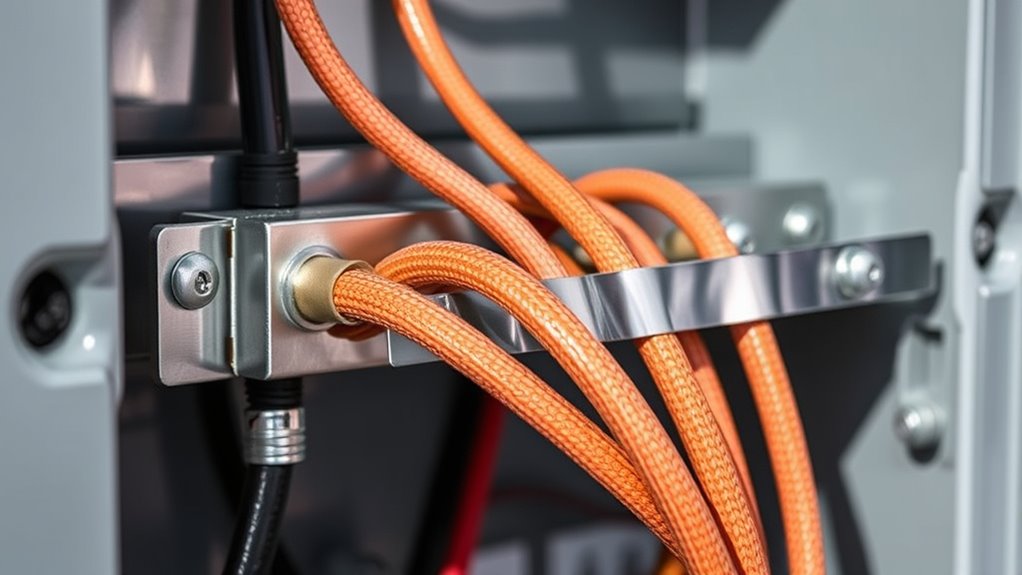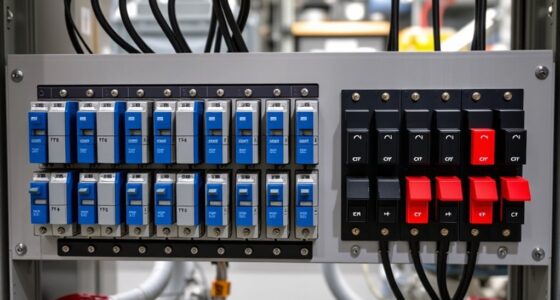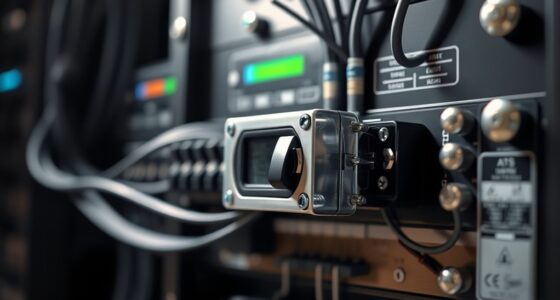When setting up a transfer switch, it’s essential to properly ground the system and bond the neutral conductor correctly. This ensures a safe path for stray currents, reduces shock hazards, and meets electrical codes. Typically, the transfer switch should be connected to a grounding electrode system, and the neutral should be bonded at only one point to prevent potential issues. Understanding these steps helps keep your system safe and reliable—keep going to learn how to do it right.
Key Takeaways
- Proper grounding of the transfer switch connects it to the grounding electrode system for safety.
- Neutral bonding at the transfer switch creates a single point connection between neutral and ground.
- Bonding ensures all metal parts are at the same potential, reducing shock risks.
- Follow manufacturer instructions and local codes for correct grounding and neutral bonding procedures.
- Regular inspections maintain proper connections, ensuring system safety and compliance during backup power use.

Have you ever wondered why proper grounding and neutral bonding are essential for transfer switches? When you’re managing backup power systems, ensuring your transfer switch is correctly grounded isn’t just a technical detail—it’s a vital safety measure. Generator grounding is a fundamental part of this process, as it helps prevent electrical shock hazards and protects your equipment from electrical faults. Proper grounding involves connecting the transfer switch and generator to a grounding electrode system, which provides a safe path for stray currents to dissipate into the earth. Without this, any fault current could pose serious risks to you and your property.
Proper grounding and bonding are essential safety measures for transfer switches and backup power systems.
Bonding requirements come into play alongside grounding. Bonding ensures that all metal parts of your electrical system are at the same electrical potential, eliminating voltage differences that could cause shocks. When installing a transfer switch, you must make sure that the neutral conductor is bonded to the grounding system at a single point, typically at the main service panel. This bonding helps maintain a clear reference point for the system’s voltage, reducing the chance of floating potentials that could lead to dangerous shocks or equipment damage. It’s crucial to follow the bonding requirements outlined by electrical codes and manufacturer instructions because improper bonding can compromise system safety and operation.
In transfer switch setups, generator grounding is particularly important because it affects how the entire system handles fault currents. If the generator isn’t properly grounded, fault currents might not have a safe path, increasing the risk of electrical shock or fire. Additionally, the grounding system helps limit transient voltage surges that can damage sensitive electronics. When you adhere to bonding requirements, you’re ensuring that the neutral and grounding conductors are correctly configured, which maintains system stability and safety.
It’s also vital to recognize that grounding and bonding are not one-size-fits-all; they depend on your specific generator type, load demands, and local electrical codes. Always consult the manufacturer’s instructions and local regulations to determine the correct procedures. Properly grounding and bonding your transfer switch system also means regular inspections and maintenance, ensuring connections remain secure and compliant over time. Cutting corners here isn’t worth the risk—your safety and the reliability of your backup power depend on it.
Additionally, understanding the importance of electrical safety standards can help you ensure that your system remains compliant and safe. By understanding and applying these principles, you’re ensuring a safe, efficient, and code-compliant transfer switch system that will serve you reliably during emergencies.
Frequently Asked Questions
Can Transfer Switch Grounding Affect System Noise Levels?
Yes, your transfer switch grounding can affect system noise levels. Poor grounding may create a ground loop, which amplifies electromagnetic interference (EMI). This interference can cause humming or buzzing sounds in audio or sensitive electronic equipment. Ensuring proper grounding reduces ground loops and minimizes EMI, leading to quieter operation and improved system stability. Properly bonded and grounded transfer switches are essential for maintaining low noise levels in your system.
Are There Specific Codes for Neutral Bonding in Different States?
You’ll find that state regulations often set specific bonding practices, including neutral bonding requirements, which vary across states. Some states mandate that the transfer switch’s neutral be bonded to the grounding system, while others don’t. It’s essential to verify your local electrical codes because these rules ensure safety and compliance. Staying informed about your state’s regulations helps you install your transfer switch correctly and avoid potential issues down the line.
How Often Should Transfer Switch Grounding Connections Be Inspected?
You should perform transfer switch maintenance, including grounding inspection, at least once a year. Regular grounding inspection frequency helps make sure your system remains safe and functional. During each inspection, check all grounding connections for corrosion, looseness, or damage. Promptly address any issues you find. Consistent maintenance not only prolongs the life of your transfer switch but also guarantees reliable operation during power outages, keeping your system compliant with safety standards.
Can Improper Grounding Cause Transfer Switch Failure?
Sure, ignoring proper grounding practices can turn your transfer switch into a drama queen. When you skip or mess up grounding connections, you risk transfer switch faults, which can cause it to fail unexpectedly. Faulty grounding creates electrical chaos, making the switch less reliable and more prone to failure. So, keep those grounding connections tight and correct—your transfer switch depends on it to avoid a costly, embarrassing breakdown.
Is Special Training Required for Proper Neutral Bonding Procedures?
Yes, you need special training to follow proper bonding procedures and grounding standards. Understanding the correct methods for neutral bonding guarantees safety and compliance with electrical codes. You’ll learn how to properly bond the neutral to prevent electrical hazards and ensure reliable operation. Proper training helps you avoid mistakes that could lead to equipment failure or safety issues, making it essential for anyone working with transfer switches.
Conclusion
Remember, proper transfer switch grounding and neutral bonding are like the foundation of a sturdy house—you might not see it, but it keeps everything safe and running smoothly. I once heard of a homeowner who neglected grounding during a storm, resulting in a power surge that damaged appliances. Don’t let that be you. Ensuring correct setup is your shield against unexpected surges, much like a strong foundation protects a home during a storm. Stay grounded, stay safe.









